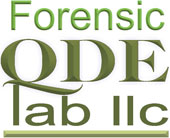There is no magic to comparing the handwriting of a questioned document with samples of another writer. Nor are handwriting experts necessarily gifted with some supernatural ability to identify the signatures of others. What a handwriting expert does have is a peculiar interest in the fine details of handwriting and many hours of training and experience in observing the characteristics of hundreds (make that, thousands) of writers. To become an expert, a document examiner must have the ability to differentiate the individualizing characteristics from “run-of-the-mill” features referred to as class characteristics found in many people’s handwriting. When considered in combination, an adequate number of these characteristics can serve as an identifying “fingerprint” of a given writer. The only “trick” is that the document examiner must have the skill to know what is adequate for such an identification.
The process of preparing the evidence for examination is rather straightforward and somewhat rudimentary. Many examiners prefer to place the signatures side-by-side, comparing the signature in question with those known to be genuine. Most commonly, each document is scanned, the image is cropped to eliminate extraneous printing or writing and the resulting signatures are “pasted” onto a sheet – Questioned signature(s) on one side, Known signatures on the other. Sometimes, preparing the documents for analysis takes longer than the analysis itself, partly because the similarities and differences become more recognizable when the writing is isolated from the rest of the page.
Then the comparison begins. A global inspection comes first. The questioned signatures are compared to one another as are the known signatures. Discrepancies and commonalities are noted. Once the examiner has a general impression of the writing, the details of the writing are inspected. There are up to 40 separate features that can be used for identifying a writer, but not all of these are considered every time. Some writers have such unusual features, very few are necessary to identify the writer, while others require in-depth, stroke-by-stroke analysis to find enough features to formulate an opinion.
After all of these steps, the examiner must determine how much weight to attribute to the characteristics he or she has noted. Using a combination of training, experience and personal skill, a hypothesis is gradually formed and tested until the examiner arrives at an opinion with a chosen level of confidence. This is usually not an overnight process, either. Most examiners prefer to revisit their evidence more than once on different days – looking at the information with fresh eyes. What is perhaps a two to four-hour examination is accomplished in a series of short visits over two or more days.
Handwriting comparisons are performed to identify a writer, to confirm the authenticity of a writing or to eliminate a writer as the author of a given document. If you have a document with handwriting in question and send it to a be analyzed, don’t expect magic, but do expect attention to detail, careful circumspection and an unbiased opinion from your forensic document examiner.
(This article is a description of an examination of photocopies, not original “wet” ink handwriting)
